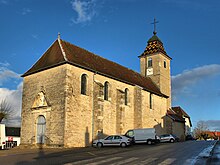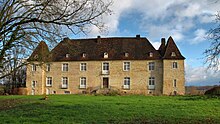Recologne (Doubs)
| Recologne | ||
|---|---|---|
|
|
||
| region | Bourgogne-Franche-Comté | |
| Department | Doubs | |
| Arrondissement | Besançon | |
| Canton | Saint Vit | |
| Community association | Val Marnaysia | |
| Coordinates | 47 ° 16 ′ N , 5 ° 50 ′ E | |
| height | 201-268 m | |
| surface | 6.78 km 2 | |
| Residents | 653 (January 1, 2017) | |
| Population density | 96 inhabitants / km 2 | |
| Post Code | 25170 | |
| INSEE code | 25482 | |
Recologne is a French municipality with 653 inhabitants (as of January 1 2017) in Doubs in the region Bourgogne Franche-Comté .
geography
Recologne is located at an altitude of 212 m above sea level, about 16 kilometers west-northwest of the city of Besançon (as the crow flies). The village extends in the gently undulating landscape between the rivers of Doubs in the south and Ognon in the north, in a wide valley at the confluence of the Ruisseau de Noironte and Ruisseau de Recologne.
The area of the 6.78 km² municipal area includes a section south of the Ognon. The central part of the area is taken up by the wide valley plain of the Ruisseau de Recologne (also called Ruisseau du Breuil), which averages 210 m. The stream provides drainage to the northwest to the Ognon. The area is mainly made up of arable land and meadows, there are also some forest areas. To the east, the community soil extends into the valley basin of the Ruisseau de Noironte. The valley level is flanked on both sides by hills, which usually do not tower above the valley floor by more than 40 meters. At 268 m, the highest point in Recologne is reached on the plateau-like hill south of the village. In the north, the municipal area extends into the extensive forests of Bois d'Avaux and Bois des Fouchères .
Neighboring municipalities to Recologne are Chevigney-sur-l'Ognon in the north, Noironte in the east, Placey and Franey in the south and Ruffey-le-Château in the west.
history
Various ceramic finds indicate that the municipality of Recologne was already settled in Gallo-Roman times. The place is first mentioned in 1139 under the name Recolinis . Over time, the spelling changed from Recoloignes (1287), Recolennes (1298), Recoloynes (1325) and Recoulongnes (1545) to Recolonges-les-Marnay (1667).
In the Middle Ages, Recologne first belonged to the Corcondray rule, then experienced various changes of ownership from the 14th century and was also subject to the rule of the Abbey of Saint-Paul of Besançon. During the Thirty Years' War , the place was ravaged by the plague epidemics in 1632 and 1636 and was also sacked by French troops in 1636. The castle was rebuilt in 1640 and passed to the Camus family in 1746. Together with Franche-Comté , Recologne finally came to France with the Peace of Nijmegen in 1678. Today Recologne is a member of the Val Marnaysien municipal association .
Attractions
- The Saint-Barthélemy church was built from 1743 to 1756 in the classical style and has a rich interior .
- Near the Ruisseau de Noironte is the rectangular, 40 m long castle, which was rebuilt in the 17th century and redesigned in the 19th century.
- The old town center is characterized by various farmhouses from the 17th to 19th centuries in the characteristic style of Franche-Comt: é.
population
| Population development | |
|---|---|
| year | Residents |
| 1962 | 261 |
| 1968 | 256 |
| 1975 | 337 |
| 1982 | 392 |
| 1990 | 482 |
| 1999 | 508 |
| 2016 | 650 |
With 653 inhabitants (as of January 1, 2017), Recologne is one of the small communities in the Doubs department. After the population had decreased significantly in the first half of the 20th century (415 people were still counted in 1911), strong population growth has been recorded again since the beginning of the 1970s. Since then the number of inhabitants has more than doubled.
Economy and Infrastructure
Until well into the 20th century, Recologne was primarily a village characterized by agriculture (arable farming, fruit growing and cattle breeding). In addition, there are now a few local small businesses, mainly mechanical workshops. In the meantime, the village has also turned into a residential community. Many workers are commuters who work in the Besançon agglomeration.
The village is well developed in terms of traffic. It is on the main D67 road from Besançon to Gray . The village center is relieved of through traffic by a bypass. The closest connection to the A36 motorway is around ten kilometers away. Further road connections exist with Noironte, Lavernay, Burgille and Chevigney-sur-l'Ognon.


